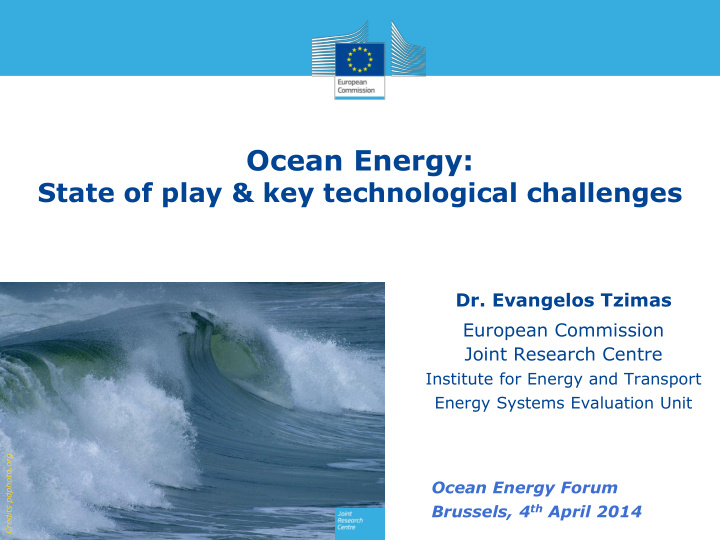



Ocean Energy: State of play & key technological challenges Dr. Evangelos Tzimas European Commission Joint Research Centre Institute for Energy and Transport Energy Systems Evaluation Unit Credits pdphoto.org Ocean Energy Forum Brussels, 4 th April 2014
Ocean Energy: An important element of the future European energy system The Energy 2020 Strategy has called Ocean Energy "an avenue of great potential". The Energy Technologies and Innovation Communication has identified Ocean Energy as a priority area for Research and Innovation. Blue Growth and Blue Energy Communications have recognised the Ocean Energy potential to enhance the security of energy supply, reduce GHG emissions, create jobs and support sustainable growth in remote areas. Currently, an Integrated Roadmap is under Total EU R&D investment in 2011 development with the active participation of the ocean European Public RD&D energy community, identifying key research and funding investment 18% 32% innovation actions to address the challenges of the Corporate European energy system. R&D investment An Action Plan of joint and individual investments in 50% support of the Integrated Roadmap will follow. 125 MEUR Source: JRC Report on marine energy innovation (2013)
State of play of Ocean Energy in the EU Global Ocean Energy RD&D in M € Australia: Current status of Ocean Energy in Europe : 1.242; 2% • EU is a global leader in ocean energy United States: Canada: New Zealand: 19.945; 26% 8.694; 12% 0.738; 1% • Increased number of technologies nearing commercialisation South Korea: 5.143; 7% • Increased number of projects announced EU: 39.346; 52% • New mechanisms to support ocean energy at EU and national levels (e.g. NER300/MEAD) Ocean Energy Projects in the EU United Kingdom Portugal Commissioned However: Spain Financing secured/Under construction Norway Announced/Planning • LCoE too high compared to other RES France Operations suspended Denmark Partially commissioned • Devices at advanced TRL but none Sweden Permitted commercially viable yet Reunion Project abandoned Ireland Faroe Islands 0 10 20 30 40 50 60 70 Source: JRC Report on marine energy innovation (2013)
Technology challenges Enabling ocean energy technology: Wave energy Attenuator • Develop effective, reliable and cost- 7% 1% 7% Oscillating Wave Surge competitive technologies to fully grasp the Converter 3% 40% Point absorber European potential Oscillating water column 23% • Follow different development paths for Bulge wave Rotating mass wave and tidal 19% Other Technology fragmentation: • Identify common components to develop Tidal energy supply chains 2% 2% Oscillating Hydrofoil Risk management: Vertical axis turbine Horizontal axis turbine • Encourage investments to promote 16% Enclosed Tips demonstration and early arrays 76% Other Designs 4% Grid access and infrastructure: • Develop/adapt grid infrastructure to integrate ocean farms Source: JRC Report on marine energy innovation (2013)
Other issues limiting Innovation Public R&D Investment Despite the growing interest in ocean energy by 30.0 25.0 2010 2011 Average 2006-2010 academia, human skills are relatively limited 20.0 M € when compared to those available for other 15.0 10.0 technologies (~5 % of offshore wind). 5.0 0.0 Research and demonstration is driven mainly by knowledge from academic spin-offs and start- ups. Scientific knowledge production Total R&D investment remains limited, e.g. 10% WP in peer-reviewed conferences Peer-reviewed papers of that for offshore wind. 250 220 183 200 number of Papers Lack of stable targets may hinder innovation 133 150 activities. 102 100 78 69 64 51 50 23 13 13 12 0 1998 2000 2003 2005 2007 2009 2011 Source: JRC Report on marine energy innovation (2013)
Overcoming technology challenges Source: SI Ocean – Wave and Tidal Energy Strategic Technology Agenda (2014) Technology Development – Developing reliable, survivable and efficient technology: • Reliability and performance • Standardisation • European industrial co-operation • Synergies with offshore wind Deployment and Risk Reduction – Increase deployment rate: • Facilitating access to European test and demonstration facilities • Logistics: installation, operations and maintenance • EU cross-industry co-operation for serial manufacturing • Ocean energy grid integration
Expected impact Demonstration of advanced technologies: 70 70 • Pilot array deployment (TRL >8) Tidal Wave 60 60 • Full-scale testing (TRL 5-7) LCOE (c € /kWh) 50 50 Performance and reliability: 40 40 • Capacity factors >25 – 30% • Availability of devices >75 – 85% 30 30 20 20 Supply chain consolidation: 10 10 • Optimisation and standardisation of manufacturing 0 0 0.02 0.06 0.2 0.6 2 6 20 60 • Components and materials Cumulative deployment GW Source: SI Ocean – Wave and Tidal Energy Strategic Technology Further reduction of CAPEX and Agenda (2014) OPEX: • Best-practice of installation and operational procedures • Marine support services
Synergies with offshore wind Wave & tidal Offshore wind Source: JRC own analysis More than 40% of offshore energy costs can be reduced by common RD&D actions • Common offshore grid infrastructure and land connectors • Similar equipment, infrastructure, operating and maintenance practices • Shared project development and permitting Business models for integrated farms: increased energy yield, reduced variability
Key developments needed: Deliver competitive technological • solutions Foster innovation through a • market driven framework LCOE Time
Thank you very much! http://setis.ec.europa.eu/ 14 April 2014 10
Recommend
More recommend